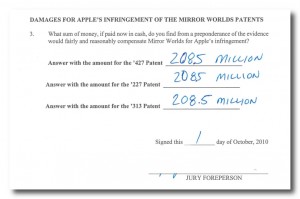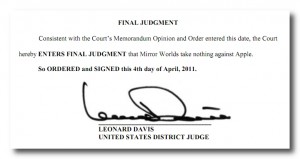AMP v. USPTO: Myriad wins this battle, but will the war continue?
 Ryan Chirnomas, Partner in the Biotechnology group at Westerman, Hattori, Daniels and Adrian, sent in this article discussing Friday’s Court of Appeals for the Federal Circuit decision in the AMP v. USPTO case. He highlights the key points of the decision and why this decision should come as a relief to anyone in the biotechnology industry.
Ryan Chirnomas, Partner in the Biotechnology group at Westerman, Hattori, Daniels and Adrian, sent in this article discussing Friday’s Court of Appeals for the Federal Circuit decision in the AMP v. USPTO case. He highlights the key points of the decision and why this decision should come as a relief to anyone in the biotechnology industry.
After nearly four months of consideration[1], the Court of Appeals for the Federal Circuit issued a decision in the controversial AMP v. USPTO case on Friday, July 29, 2011. Weighing in at just over a hundred pages total, the decision includes a majority opinion by Judge Lourie, a concurrence by Judge Moore and a dissent by Judge Bryson. The main point of contention between the three opinions relates to the patent-eligibility of the composition claims, particularly the claims which recite isolated long DNA sequences.
Standing
The first issue considered by the CAFC was whether the Plaintiffs had standing to sue. The Plaintiffs were a motley crew of doctors, patients, scientific organizations and advocacy groups. This wide breadth of Plaintiffs was one of the unusual aspects of this case. Some Plaintiffs, such as cancer patients, claimed standing based on the fact that they could not afford the costs of the genetic tests or obtain a second opinion, due to Myriad being the exclusive provider for this test in the United States. The Court quickly dismissed this reasoning, stating that “we fail to see how the inability to afford a patented invention could establish an invasion of a legally protected interest for purposes of standing.” Citing MedImmune, the Court succinctly stated: “[s]imply disagreeing with the existence of a patent or even suffering an attenuated, non-proximate, effect from the existence of a patent does not meet the Supreme Court’s requirement for an adverse legal controversy of sufficient immediacy and reality to warrant the issuance of a declaratory judgment.”
Supreme Court Grants Certiorari In Prometheus V. Mayo (Again)
 On Monday, the United States Supreme Court agreed to consider whether to set limits on when inventors can patent medical diagnostic tests. Our friends at Foley & Lardner sent in this article discussing the history of the case, the issues being considered by the Court and the potential impact this case may have on intellectual property in the personalized medicine space.
On Monday, the United States Supreme Court agreed to consider whether to set limits on when inventors can patent medical diagnostic tests. Our friends at Foley & Lardner sent in this article discussing the history of the case, the issues being considered by the Court and the potential impact this case may have on intellectual property in the personalized medicine space.
On June 20, 2011, the United States Supreme Court granted Mayo’s petition for certiorari in Prometheus Laboratories, Inc. v. Mayo Collaborative Services, 628 F.3d 1347 (Fed. Cir. 2010), a case addressing patent eligibility under 35 U.S.C. § 101 of certain method claims relevant to personalized medicine. While the issue under consideration here does not relate to whether isolated genes and other alleged “products of nature” are patent-eligible, the Court in Prometheus will likely address whether and how one can claim methods that take advantage of correlations between an individual’s personal health/genetic make-up and possible health care options.
As discussed in postings on Foley’s Personalized Medicine Bulletin and PharmaPatents blogs, Mayo Collaborative Services filed a second petition for certiorari with the Supreme Court after the Federal Circuit upheld the claims (for a second time) on remand after the Supreme Court’s decision in Bilski v. Kappos (2010). Representative claims in Prometheus include: (more…)
06.22.11 | Bilski, biotechnology patents, posts, Supreme Court Cases | Stefanie Levine
Court Vacates $626 Million Jury Verdict Due To Plaintiff’s Fundamental (And Easily Correctable) Errors
Written by Brandon Baum , of baum legal and Practice Center Contributor.
Question: How do you turn this
Into this?
Answer: By failing to establish each and every requirement of the patent law on the record at trial in a manner sufficient to sustain the jury’s verdict.
Mirror Worlds (MW) accused Apple of infringing three patents allegedly used in Apple’s “Cover Flow,” a feature familiar to ipod and Mac OS users. The asserted claims of the three patents-in-suit included a variety of method and system claims, and MW relied on theories of both direct and indirect infringement, and sought to prove infringement both literally and, for some limitations, under the doctrine of equivalents. The jury found infringement and awarded MW a total of $625.5 million in damages. However, the trial judge overturned that verdict and granted judgment instead to Apple. Why? Did MW overlook some subtle nuance of patent law? Was the technology just too complex for the jury to understand? No, the explanation is far far simpler than that. (more…)
04.8.11 | Federal Circuit Cases, Patent Litigation, posts | Stefanie Levine
AMP v. U.S.P.T.O.: Oral Argument at the Federal Circuit
 Yesterday, the much anticipated oral argument in the AMP v. USPTO aka the Myriad Case took place at the Court of Appeals for the Federal Circuit. Fortunately for us, Ryan B. Chirnomas, Partner at Westerman, Hattori, Daniels & Adrian attended the argument and has passed along this article summarizing the day’s events.
Yesterday, the much anticipated oral argument in the AMP v. USPTO aka the Myriad Case took place at the Court of Appeals for the Federal Circuit. Fortunately for us, Ryan B. Chirnomas, Partner at Westerman, Hattori, Daniels & Adrian attended the argument and has passed along this article summarizing the day’s events.
On April 4, 2011, the Appellant, Appellee and the U.S. Government presented oral argument before the Court of Appeals for the Federal Circuit in AMP v. USPTO, which deals with gene patenting. The parties in this case are the Association for Molecular Pathology, along with many other medical organizations, doctors and patients on one side, and the U.S.P.T.O., Myriad Genetics, Inc., and the University of Utah Research Foundation on the other side. Many amicus briefs have been filed as well. The argument was heard by a panel consisting of Judges Bryson, Lourie and Moore, and was attended by approximately 200 people. Due to the complexity of the subject matter and the presence of Government, the Court granted each side approximately 30 minutes of argument, instead of the usual 15 minutes.
Interestingly, although the parties seemed eager to discuss the merits, approximately half of the time for the Appellant and Appellee was spent discussing the issue of jurisdiction and standing. In particular, Judge Moore seemed very interested in this issue. The Appellants, led by Myriad, argued that there was no immediate controversy between the parties, since Myriad had not contacted any of the parties in over ten years. However, Judge Moore questioned whether those parties previously threatened by Myriad were still refraining from making and using the claimed subject matter due to a continuing fear of litigation over the past decade. (more…)
04.5.11 | biotechnology patents, posts | Stefanie Levine
Divided Infringement: Strategies For Drafting Claims
 Dale Lazar, Partner at DLA Piper and Practice Center Contributor , sent in this article discussing divided infringement and how it generally pertains to large systems and corresponding methods. Lazar will be speaking tat PLI’s Patent Law Insitute this Thursday, February 17th. The following is an excerpt from the aticle.
Dale Lazar, Partner at DLA Piper and Practice Center Contributor , sent in this article discussing divided infringement and how it generally pertains to large systems and corresponding methods. Lazar will be speaking tat PLI’s Patent Law Insitute this Thursday, February 17th. The following is an excerpt from the aticle.
Divided infringement issues are most likely to arise in the context of large systems and corresponding methods, where multiple parties may contribute to or participate in the system. A common instance where divided infringement is likely to arise is a network of computers where the functionality of the system is distributed across the computers of the network. The network employed to connect the computers may be a LAN/WAN and/or the Internet. Particularly where different computers perform different functions for the overall system, the different computers may be owned or operated by different parties, typically with each party not being controlled by other parties involved with the system.
Included at the end of this paper is a patent application directed to a “Reliance Server for a Transaction System”. In many ways, the invention is typical of Internet-based inventions – inventions that are implemented over an open communications channel, such as the Internet. The application has been simplified to focus on only a few of the features of the invention. Please read the application as a basis for understanding the following remarks concerning divided infringement. (more…)




No Comments
08.1.11 | biotechnology patents, Federal Circuit Cases, posts | Stefanie Levine